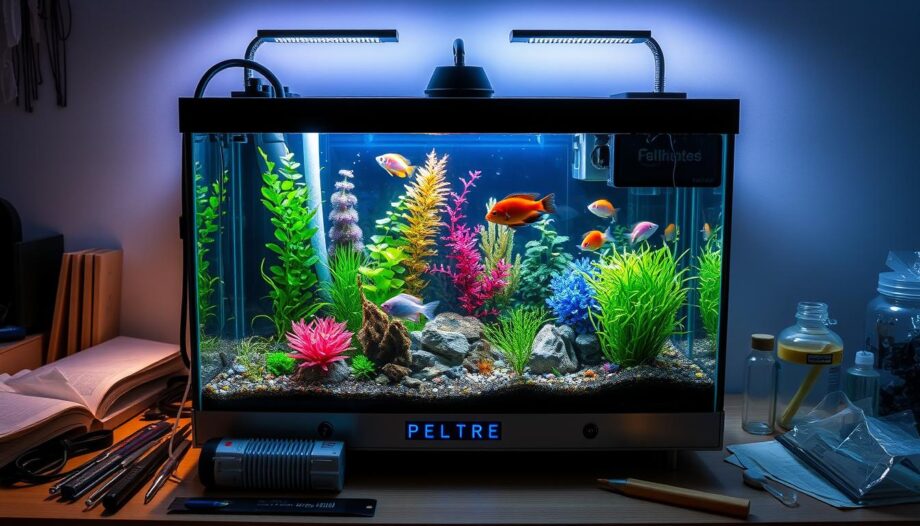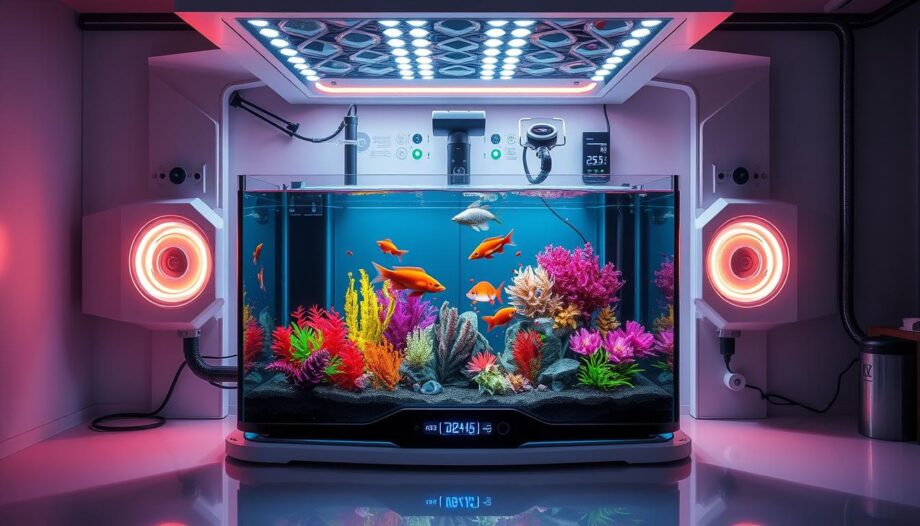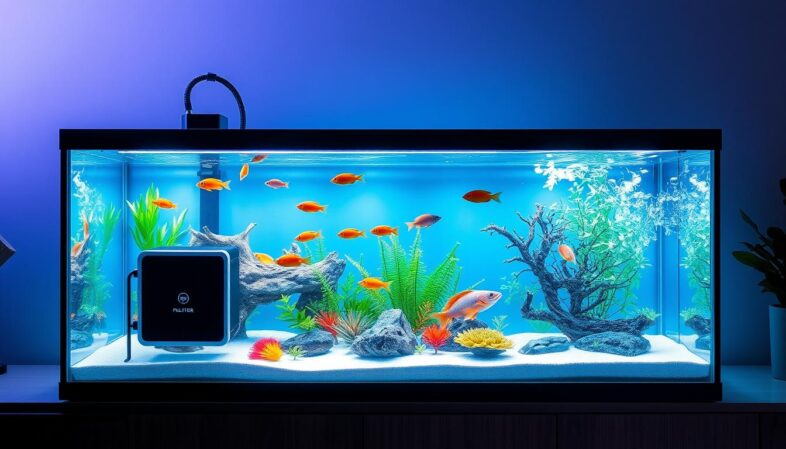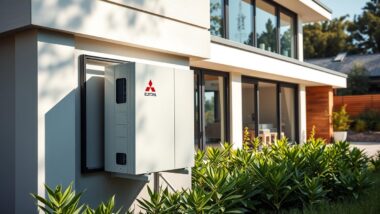Ever thought about keeping your aquarium at the perfect temperature easily? Peltier Aquarium Heating and Chilling technology offers a modern solution. It's efficient and compact, unlike old heating and cooling systems. In theory Peltier devices can heat and chill water, giving you full control over your aquarium's temperature1. The reality is that there are still very few Peltier devices that have been commercially developed for use by aquarists. We only saw one or two when writing this in January 2025.
In this article, we'll explore Peltier technology for aquariums. We'll look at its potential benefits and how it works in practice.
Peltier technology, or thermoelectric cooling, is becoming more popular among interested hobbyists. It moves heat using electricity, which would be great for aquariums. Keeping the water at the right temperature is key for fish and plants1. Plus, Peltier devices are potentially energy-saving and small, perfect for today's aquariums.
Peltier Aquarium Heating – Key Points
- Peltier Aquarium Heating technology offers a bidirectional approach to aquarium temperature management, capable of both heating and chilling water but is not so far commercially available in many products1.
- The cost for controlling a Thermoelectric Cooler (TEC) can be relatively high but offers precise temperature control1.
- Modern aquarium chillers using conventional heat pump/ chiller technology typically require 8.3 BTU/hr to lower the temperature of one gallon of water by 1°F2.
- A 55-gallon aquarium would need a chiller rated at least 2,200 BTU/hr to achieve a 4°F temperature drop2.
- Peltier devices stand out for their compactness and energy efficiency, making them ideal for modern aquarium setups in theory but it is still early days for their use.
Introduction to Peltier Technology
Peltier technology could be key in many fields, like aquariums. It's all about controlling water temperature precisely. This tech uses thermoelectric heating and cooling to keep aquariums perfect. Since its discovery, Peltier tech has held a promise to change how we control temperatures.
What is Peltier Technology?
Peltier tech works by the Peltier effect, found by Jean Charles Athanase Peltier in 1834. It happens when electricity flows through two different materials, making one hot and the other cold. This lets Peltier heaters both warm and cool without moving parts or refrigerants. They use special materials to pump heat, depending on the current and their design3.
History and Development
Peltier tech started in the 19th century but took time to be useful. It has hardly begun to be implemented in commercial products and buyers must still be content with other heating and cooling methods. But, new materials and making techniques may yet modern Peltier devices competitive. Nowadays, they can have a coefficient of performance (COP) from 0.3 to 0.7, and even more in certain cases3.
Advances may mean that this will make Peltier heaters a top pick for all precise and reliable temperature control needs.
Core Principles of Peltier Aquarium Heating
Peltier tech moves heat through special modules. These modules can handle small to big heat removal tasks3. Peltier tech is in theory great for keeping water in aquariums at the right temperature. It balances heating and cooling to keep the water stable for fish and plants.
For best results, Peltier modules could possibly run at 80% or less of their max power. This way, they can transfer up to 180W of heat4.
Benefits of Peltier Technology in Aquariums
Peltier technology would bring many benefits for keeping aquariums at the right temperature. This technology would potentially help keep the water at the perfect temperature for all kinds of fish and plants.
Energy Efficiency
Peltier devices are very good at saving energy. They use less power than old-fashioned heaters. For example, a 300-watt Peltier chip only needs 12V DC and 25 amps to work well5.
This is important because it saves money. It's also key in hot summer months. Many fish, like newts and axolotls, can't handle the heat well6.
Compact Design
Peltier devices are also very small. They fit easily in tight spaces. This would be great for both small and medium tanks.
For example, a 5 or 10-gallon tank is perfect for Peltier heaters5. They would let you control the water temperature without taking up too much space.
Cost-Effectiveness
Peltier technology might also be very cost-effective. It could become cheaper to run and maintain than old systems. Peltier devices may use less energy and last longer.
They may also become good for saving money in the winter. Some fish need cooler water to breed well6.
Peltier Aquarium Heating
Peltier aquarium heating systems are a new way to keep fish tanks warm (or cold!). They use Peltier technology to control the temperature. This makes sure the water is just right for different fish.
A Peltier module for heating needs a strong power supply. It can use up to 6-7 amperes at 12V7. Some Peltier elements can get up to 57W hot at 50 degrees Celsius7. But, not all Peltier devices work best at 12V. Some need 8V, so picking the right parts is key7.
“Peltier technology converts electrical energy into a temperature difference. It can heat or cool aquariums. Its small size makes it easy to fit in most tanks, offering a neat way to control the temperature.”
The efficiency of a Peltier heater depends on how it's set up and the room temperature. Keeping the tank well-insulated and using the right lights helps7. Also, getting a good Peltier system is important. For example, a Peltier Aquarium Thermoelectric Cooler System is available for US $44.55, with free shipping8.
- The delivery time for this system is between Thu, Jan 23 and Mon, Jan 278.
- The seller offers a 30-day return policy, covering return shipping8.
- The seller has high ratings for accurate description, shipping cost, speed, and communication8.
- The device we saw (January 2025) was sold as: “Suitable for semiconductor learning and research and solution development equipment planning in narrow spaces.”
In summary, Peltier technology can, in theory, be great for keeping fish tanks warm, or cool. Knowing the technical details and choosing the right parts helps create a stable home for fish. But at the time of writing you would need to be a competent DIYer and clever at adapting the available parts to work in your setup.
| Peltier Heating System | Key Specifications | User Ratings |
|---|---|---|
| Power Draw | 6-7A at 12V | N/A |
| Output | 57W at 50°C | N/A |
| Seller Rating | TBD | 4.9/5.0 |
| Price | US $44.55 (8% discount) | Shipping: FREE |
| Return Policy | 30 days (seller covers shipping) | N/A |
DIY Approaches to Peltier Aquarium Systems
Building a Peltier aquarium setup yourself can be fun and rewarding. If adapted well it should let you control the water temperature perfectly. Knowing what parts you need and the possible problems would help make the process easier.
Essential Components
A DIY Peltier aquarium needs a few key parts. First, you'll need a Peltier device, which uses up to 10A of current9. You'll also need a high-power H-bridge controller like the BTS7960, which can handle up to 43A and connect up to four Peltier devices9. A stable PSU with a 375W output is crucial for reliable operation9. Also, using 12V 18A bridge rectifiers rated for 50A helps power conversion9.
Common Challenges
One big problem is getting rid of the extracted heat. Turbo fan heatsinks, which move about 30 CFM of airflow per fan, help cool the Peltier devices10. Another issue is getting the cooling right; for example, cooling an aquarium from 80°F to 75°F in 32 minutes might not always work10. You need to consider whether rapid cooling would be comfortable, or even healthy, for your fish.
It's also important to make sure the power supply can handle the load, as a PSU rated for 17 Amps at 12 Volts might not be enough10.
Step-by-Step Guide
- Gather the needed parts: Peltier devices such as, BTS7960 H-bridge, PSU, bridge rectifiers, transformers, and cooling fans.
- Prepare the PSU: Make sure it can deliver up to 375W of power and has a 12V output rated at 18A9.
- Install the Peltier device(s): Secure them well, ensuring good thermal contact for efficient heat transfer9.
- Set up the H-bridge: Connect the Peltier devices to the H-bridge controller (e.g., BTS7960), which can supply up to 43A, enabling up to four Peltier devices working simultaneously9.
- Integrate the cooling system: Use turbo fan heatsinks to ensure proper heat dissipation, capable of moving approximately 30 CFM per fan10.
- Power Management: Implement bridge rectifiers rated for 50A and consider PWM for control, ensuring the power supply can handle the setup
- Testing and calibration: Start the system and monitor the temperature changes, making necessary adjustments to the fan speed or modifying the number of Peltier devices to achieve desired performance. This might involve trial and error, such as noting initial cooling performance and then tweaking for best results10.

By choosing the right parts and understanding common problems, you can build a Peltier aquarium system that meets your needs. This approach might be cost-effective on energy use and also lets you customize your aquarium's temperature management.
Watch the step by step guide below:

Alternative Materials for Effective Thermal Conductivity
Finding the right thermal conductivity materials is key for aquariums. Copper and aluminum are popular for their good thermal properties. For example, copper plates of 1 to 2 mm are often suggested for Peltier setups11.
Research is looking into thermal conductive fabrics. These are used in cooling clothes for extreme jobs like firefighting11. They are thin but effective for managing heat in aquariums11.
Silicone-based compounds are also being studied. They are good at transferring heat, which is important in electronics11. They might be used in aquariums for heating and cooling, offering a flexible solution.
Comparing glass and aluminum shows their strengths. Glass has a CTE of 8 × 10-6/K, while aluminum (6061 Al) has 23 × 10-6/K12. This means aluminum expands more than glass when heated, which is useful to know for aquarium systems.
Let's look at how glass and aluminum compare for aquarium use:
| Material | Thermal Conductivity | Coefficient of Thermal Expansion (CTE) | Ideal Thickness | Use Case |
|---|---|---|---|---|
| BK-7 Glass | 1.1 W/m·K | 8 × 10-6/K12 | 1-2 mm | Observation Windows |
| 6061 Aluminum | 167 W/m·K | 23 × 10-6/K12 | 1-2 mm | Heat Sinks |
| Thermal Conductive Fabric | Varies | Not Applicable | 2-4 mm | Cooling Garments |
These findings highlight the need to explore different efficient thermal interfaces for aquariums. By using advanced materials, we can improve the performance of Peltier-based systems.
Managing Aquarium Temperature with Peltier Devices
Peltier devices are a smart way to control aquarium temperature. They can heat and cool your tank with great precision. These devices work by creating a temperature difference and using smart control systems.
Temperature Probing and Control
Keeping your aquarium at the right temperature is key. It uses two digital sensors to check the water's temperature. These sensors are connected to the control circuit13.
The system starts cooling when the water gets too hot and heats it when it gets too cold. This keeps the water at the best temperature13. It also turns off cooling or heating when the temperature is just right, saving energy13.

You may need to wait at least 10 minutes before changing from cooling to heating. This stops the system from working too hard and breaking down13. The system uses 5V to control the switches13. According this source the 60W Peltier device handles both heating and cooling well13.
Reversing Current Flow
Reversible Peltier devices can switch between heating and cooling by changing the current flow. They use a BTS7960 H-bridge to connect and control multiple devices. Each device can draw up to 10A9.
Peltier Aquarium Heating devices can handle up to 38 watts when powered right14. The H-bridge can support up to 4 devices, making sure your system works well even when it's busy.
Standard PC power supplies can power these devices. They can give up to 18A at +12V, with a total of 375W DC output9. This means you can run many devices at once. Using PWM control can make things even more efficient, but fixed DC voltage works better9.
| Parameter | Details |
|---|---|
| Temperature Sensors Used | Two DS18B20 Digital Sensors |
| Power Consumption | 60W for Peltier Device13, 38W on Max Load14 |
| Control Circuit | Relays operating at 5V Logic Level13, BTS7960 H-bridge rated at 43A9 |
| Operating Temperature Range | Cooling above 78°F, Heating below 76.3°F13 |
| Power Source | PC Power Supply at 18A, +12V, Total Output 375W9 |
Case Study: Building a DIY Peltier Chiller
Building a DIY Peltier chiller for your aquarium is a fun and rewarding project. It's a mix of cost savings and new ideas. We'll look at the key steps and parts needed to make a working Peltier chiller system.
Project Overview
This DIY Peltier chiller aims to cool your aquarium to the right temperature, even when it's hot. It uses a Peltier module for the best cooling. This is based on the room temperature and other factors.
Materials Used
To make a DIY Peltier chiller, we chose the following materials:
- Peltier module (46W)
- Heatsinks and fans for thermal management
- Power supply unit
- Thermal interface materials like thermal paste
- Water block and tubing for integrating with the aquarium
- Temperature controller and sensors for Peltier system testing
The cost of these materials was much lower than buying a commercial cooler. Peltier modules cost under $3 each, plus shipping15. A thrift store dehumidifier used in one project cost about $816.
Setup and Testing
The Peltier Aquarium Heating and Chilling setup focused on managing temperature well. Here's what an experienced DIY'er might do:
- Assembled the Peltier module with heatsinks and fans for heat dissipation.
- Connected the parts to the power supply and attached the water block to the Peltier module with thermal paste.
- Linked the water block to the aquarium's tubing for heat exchange.
- Set up temperature sensors for accurate testing and control.
Testing showed the Peltier module could cool to about -16°C. This would be way beyond what's needed for fighting high temperatures that could reach 40°C in an axolotl tank15. At 80% power, the module's heating and cooling powers were around 130W and 120W, respectively. This proved it could work well for small to medium tanks4.
This DIY Peltier chiller project showed how Peltier technology can keep aquariums at the best conditions. It's cost-effective, precise, and innovative. It might be a great alternative to traditional cooling systems for the very keen DIYer!
Commercial Peltier-Based Aquarium Heaters and Chillers
Commercial Peltier chillers and heaters may become mainstream and may one day change how we manage water temperatures in aquariums. The best Peltier aquarium heaters use solid-state cooling. It's important to look at top brands and compare them to traditional methods.
Popular Brands and Models
Brands like Coralife and Chiller Daddy are known for their Peltier devices. We found a Yuecoom unit on Amazon. These can be small, quiet, and easy to move. They need some upkeep because they have moving parts in their air-fans. But they are affordable and good for many uses17.
Comparison with Traditional Systems
Peltier vs traditional chillers show a clear difference. Traditional infrared aquarium heaters use vapor-compression and also work well for big temperature drops and quick cooling17. Peltier devices can cool one gallon of water by 1°F using 8.3 BTU/hr, which saves energy2.
But, Peltier systems have trouble cooling below 10°C and cool slower than traditional ones17. Still, they offer better control in small temperature changes and are quieter17.
Also, Peltier systems are less energy-efficient for big temperature changes17. But, the best Peltier heaters are more reliable if placed right, unlike traditional systems that can fail if tilted17. This shows the trade-off between new technology and old methods, helping users choose based on their aquarium needs.
Energy Consumption and Environmental Impact
Using energy-efficient Peltier devices in aquariums cuts down on electricity use. Old heating methods need up to 5 watts per gallon. But, Peltier devices use less power, keeping water at the right temperature without wasting energy18. For example, setting a backup heater to 74 degrees saves power while keeping things running smoothly18.
Peltier tech also helps the environment. Nevertheless check energy use against Energy Star-rated traditional chillers use that also use less power, making aquarium care better for the planet19. Choosing the right chiller size helps keep water at the perfect temperature, making the system work better19.
Adding smart aquarium controllers, like Neptune Apex, makes care easier. They keep an eye on temperature and pH, keeping the water stable and healthy18. Meanwhile if noise is a problem, look out for quiet chillers (35-60 dB) to make your home aquarium quieter while still working efficiently19.
Looking at Peltier devices, we see that they will only become popular if they're better for the planet than old methods. They must use less energy and make less noise, making homes quieter and greener19.
| Parameter | Traditional Methods | Peltier Technology |
|---|---|---|
| Energy Consumption | Higher (3-5W per gallon)18 | Lower (Energy-efficient models) |
| Noise Level | Variable (35-60 dB)19 | May be quieter but will need to be optimized for quiet operation |
| Maintenance | Regular (4-6 weeks filter cleaning)19 | Possibly less frequent (due to the possibility that some systems will have no moving parts) |
| Environmental Impact | Higher due to energy use | Reduced ecological footprint |
| Operational Costs | Higher (due to traditional heaters/chillers) | Lower (efficient devices reduce electricity bills) |
Future of Peltier Technology in Aquatic Applications
Peltier technology is getting better, and it's changing the way we care for aquariums. New improvements in Peltier tech are making heating and cooling systems more efficient. This means better conditions for the fish and plants in our tanks.
Innovations and Advances
New developments are making Peltier devices work better and do more. For example, some Peltier elements can cool down to -100°C. This is a long way below keeping the air just right for our aquatic friends20, but shows that the technology is developing! It also should mean that we can control the temperature more accurately.
Also, Peltier tech is getting smaller and using less energy. These devices come in different sizes, from 20 mm to 90 mm, and are just 3 mm to 5 mm thick20
Potential Challenges
Even with all the progress, there are still some problems with Peltier tech. One big issue is how much energy it uses when you add in the drain on power when pumps and filters are needed as well. Peltier elements are not very efficient unless free from moving parts, which means they use a lot of electricity20. This can be a big problem, like when we have big tanks to keep warm or cool and must pump a lot of water through the chiller.
Another problem for room heating and many plants is controlling humidity, but thankfully not a problem for most aquatic applications. In one test, the humidity went down from 61.1% to 58.2% in 120 minutes21. This shows Peltier systems can dry out the air.
Table summarizing the performance of Peltier technology in various tests:
| Test | Start Humidity Level | End Humidity Level | Duration | Observations |
|---|---|---|---|---|
| Test 1 | 61.1% | 58.2% | 120 minutes | Ice formed on heat sink |
| Test 3 | 78% | 51.8% | 40 minutes | Effective dehumidification |
To make the most of Peltier tech in aquariums, we need to solve these problems. With more research and work, Peltier tech could be a game-changer for keeping our tanks healthy. But, we have to get past these challenges first.
Conclusion: Peltier Aquarium Heating and Chilling
Peltier technology in aquariums could bring many benefits. It controls temperature with high precision, from 5°C to 25°C or higher, which is key for aquatic life22. These devices may also b energy-saving and small, fitting well in any aquarium size. They can potentially switch between heating and cooling, making them very useful23.
But, there are challenges like keeping them either cool or warm while pumping the heat and using energy wisely24. Still, as time goes on many people will enjoy making their own Peltier systems for their aquariums. They face issues like poor insulation, but they keep improving their setups24. Companies like Zhejiang Changxin Electronic Technology Co., Ltd. are also working hard to make Peltier devices better for many uses, including homes and medical gear23.
The future of Peltier Aquarium Heating and Chilling technology in aquariums looks bright. With new ideas and a focus on green solutions, more people will use Peltier systems. More research and development will lead to better, cheaper, and greener ways to keep aquariums at the right temperature23.
FAQ
What is Peltier technology and how does it work?
How energy-efficient are Peltier devices in aquariums?
What are the advantages of using Peltier-based heaters and chillers in aquariums?
Can I build my own Peltier-based heating or cooling system for my aquarium?
What materials are best for enhancing thermal conductivity in Peltier setups?
How do Peltier Aquarium Heating and Chilling devices manage aquarium temperature dynamically?
What are some commercially available Peltier aquarium heaters and chillers?
How do Peltier devices impact the environment compared to traditional methods?
What future developments can we expect in Peltier technology for aquariums?
Peltier Aquarium Heating Source Links
- Controlling a Thermoelectric heater/chiller for environmental chamber
- How To Choose an Aquarium Chiller and How It Works
- FAQ's & Technical Information – TE Technology
- BioMONSTAAAR's Heating and Cooling System
- To peltier or not to peltier, that is the question
- Caudata Culture Articles – Cooling
- Peltier does not work (aquarium cooling project)
- Aquarium Thermoelectric Cooler Peltier System Semiconductor Water Chiller 180W | eBay
- Peltier based aquarium cooler/heater?
- DIY 200W Peltier Chiller? – Reef Central Online Community Archives
- Thermoelectric Cooling+Heating Blanket
- fullbook.thermal.pdf
- PAID simple Aquarium regulator with Peltier Cooler
- Using a Peltier cooler to refrigerate a terrarium – Outguessing the machine
- DIY Chiller idea
- DIY Chiller: Aluminum water cooling block safe?
- Peltier vs. Compressor-Based Cooling | Blog
- A Successful Saltwater Aquarium Has a Stable Climate EP: 04
- Fish Tank Water Chiller A Comprehensive Guide – Jamestownfish
- Need ideas for automating the aquarium care?
- Joseph Zoulikian Week 20
- The Role of Thermoelectric Peltier Modules in Small Household Appliances
- Building a temperature-controlled Peltier Mini Fridge



